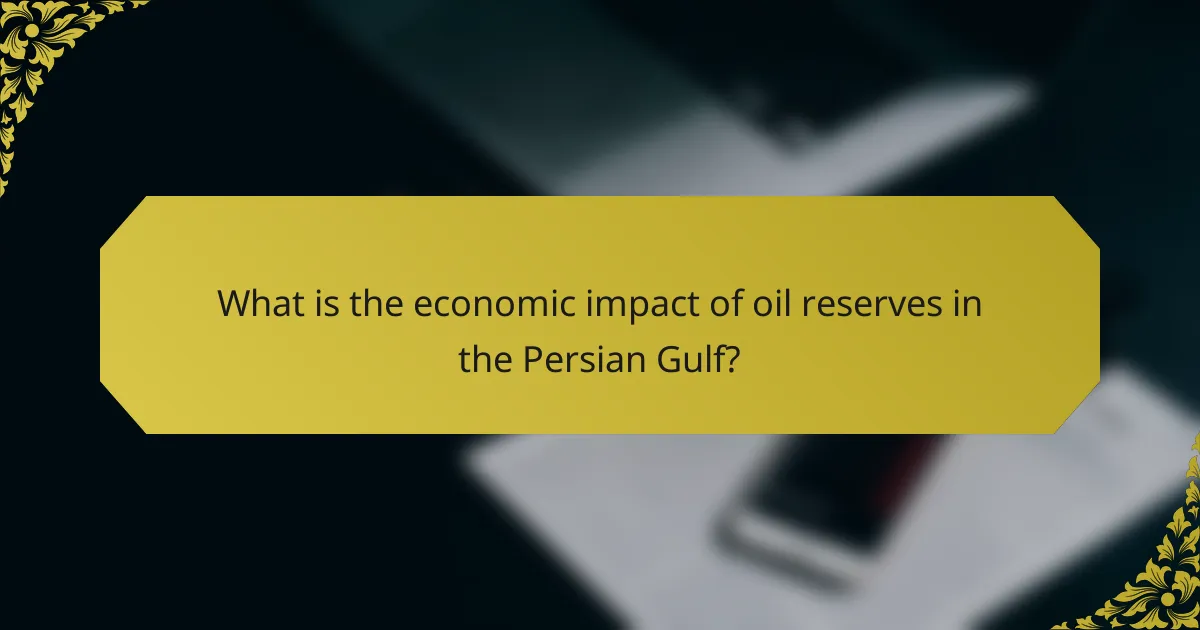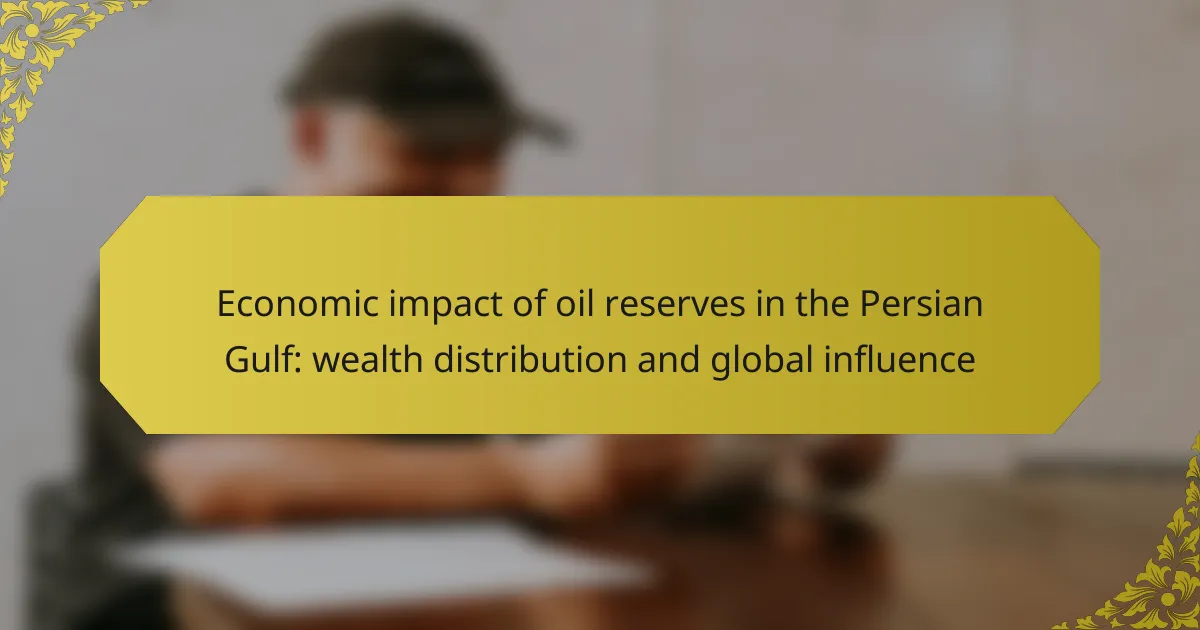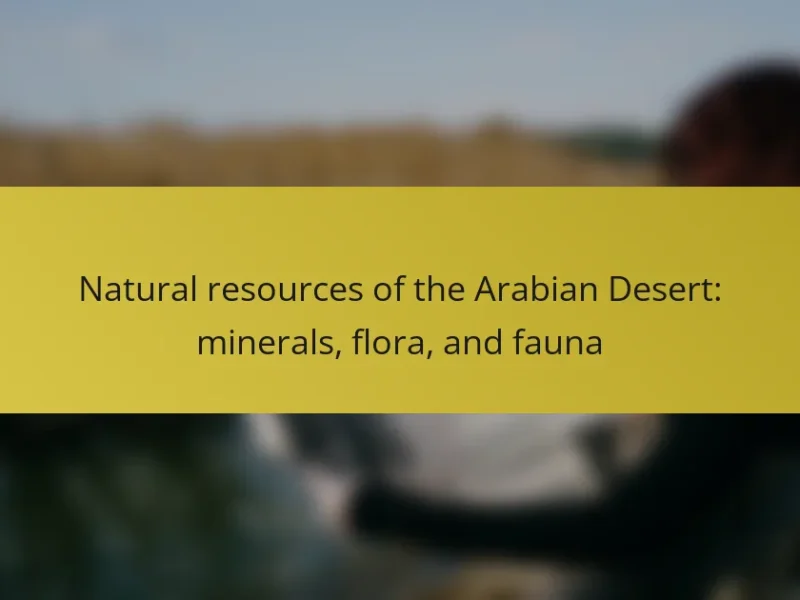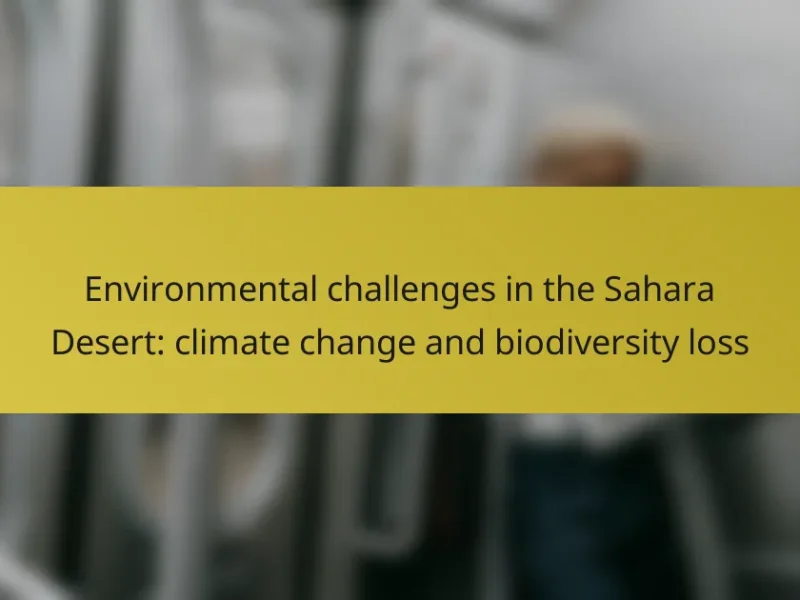
What is the economic impact of oil reserves in the Persian Gulf?
Oil reserves in the Persian Gulf significantly influence the global economy. They account for a substantial portion of the world’s oil supply. Countries like Saudi Arabia and Iraq have some of the largest reserves. These reserves generate vast revenues through oil exports. In 2021, Gulf Cooperation Council (GCC) countries earned over $300 billion from oil exports. This wealth enables significant investments in infrastructure and social programs. The economic stability of these nations often hinges on oil prices. Fluctuations in oil prices can impact global markets and economies.
How do oil reserves influence the wealth distribution in the region?
Oil reserves significantly influence wealth distribution in the region. Countries with abundant oil reserves tend to experience higher GDP per capita. This wealth often leads to increased government revenues, allowing for better public services and infrastructure. Conversely, regions with limited oil resources may face economic challenges and lower living standards. Wealth concentration can occur in oil-rich areas, leading to disparities between different regions. For instance, in the Persian Gulf, nations like Saudi Arabia and Qatar exhibit high wealth levels due to their substantial oil reserves. This creates a stark contrast with neighboring countries that lack similar resources. The distribution of oil wealth can also affect social structures and investment in human capital.
What factors contribute to wealth inequality among Persian Gulf countries?
Wealth inequality among Persian Gulf countries is influenced by several factors. The primary factor is the unequal distribution of oil reserves. Countries like Saudi Arabia and the UAE possess vast oil wealth, while others like Bahrain have limited resources. Economic diversification is another contributing factor. Nations that have successfully diversified their economies, such as the UAE, tend to have more balanced wealth distribution. Social policies also play a role. Countries with extensive welfare systems can reduce inequality, while those with less support may see greater disparities. Labor market dynamics contribute significantly as well. Many Gulf states rely on foreign labor, which can create wage gaps between locals and expatriates. Governance and political stability impact wealth distribution too. Countries with stable governments can better manage resources and investments, leading to more equitable wealth distribution.
How do oil revenues affect social services and infrastructure development?
Oil revenues significantly enhance social services and infrastructure development in oil-rich regions. These revenues provide funding for essential public services such as healthcare and education. For instance, countries like Saudi Arabia and Kuwait allocate substantial portions of their oil income to improve health facilities and schools. This funding leads to better access to quality healthcare and education for citizens. Additionally, oil revenues finance infrastructure projects, including roads, bridges, and public transportation systems. The United Arab Emirates has invested heavily in infrastructure development, resulting in modern cities and efficient transport networks. Overall, oil revenues play a crucial role in shaping the social and physical landscape of these nations.
What role do oil reserves play in global economic dynamics?
Oil reserves are crucial in shaping global economic dynamics. They influence energy prices, impacting inflation and economic growth worldwide. Countries with significant oil reserves, such as those in the Persian Gulf, gain substantial geopolitical power. These nations often leverage their resources in international relations and trade agreements. Oil exports contribute significantly to national revenues, affecting wealth distribution both domestically and globally. The global economy is sensitive to fluctuations in oil supply, which can trigger economic instability. For instance, the 1973 oil crisis led to a worldwide recession due to sudden price hikes. Therefore, oil reserves are not just resources but pivotal elements in global economic strategies and political leverage.
How do Persian Gulf oil reserves impact global oil prices?
Persian Gulf oil reserves significantly impact global oil prices due to their vast quantities and strategic importance. These reserves contain approximately 50% of the world’s proven oil reserves. When production levels from these reserves change, it directly affects global supply. For example, OPEC decisions, often influenced by Persian Gulf countries, can lead to price fluctuations. In 2020, during the COVID-19 pandemic, reduced demand and OPEC+ production cuts caused prices to drop significantly. Conversely, when tensions in the region rise, such as conflicts or sanctions, prices tend to spike due to perceived supply risks. Thus, the Persian Gulf remains a critical factor in the global oil market dynamics.
What is the significance of oil reserves in international trade relations?
Oil reserves play a crucial role in international trade relations. They significantly influence the economic power of oil-rich nations. Countries with large oil reserves often leverage this resource to gain political and economic advantages. For instance, the Persian Gulf nations, such as Saudi Arabia and the UAE, wield substantial influence in global markets. In 2022, the Gulf Cooperation Council (GCC) countries accounted for over 30% of the world’s crude oil exports. This dominance allows them to set prices and influence global energy policies. Additionally, oil reserves impact trade agreements and alliances between nations. Countries dependent on oil imports often align with major producers for energy security. Thus, oil reserves are integral to shaping international trade dynamics and geopolitical relationships.
How does the geopolitical landscape affect the economic impact of oil reserves?
The geopolitical landscape significantly influences the economic impact of oil reserves. Political stability in oil-rich regions often leads to higher investment and production levels. Conversely, instability can result in decreased output and increased risks for investors. For example, the Arab Spring in 2011 disrupted oil production in several countries. This led to fluctuations in global oil prices. Additionally, geopolitical tensions, such as sanctions on Iran, affect its oil exports. These factors ultimately shape the wealth distribution among nations dependent on oil. The International Energy Agency reported that geopolitical risks can raise oil prices by as much as 20%. Thus, the geopolitical environment directly impacts the economic viability of oil reserves.
What are the major geopolitical challenges faced by oil-rich nations in the Persian Gulf?
Oil-rich nations in the Persian Gulf face significant geopolitical challenges. These challenges include regional conflicts, particularly tensions with Iran. The rivalry between Saudi Arabia and Iran creates instability in the region. Additionally, the presence of foreign military forces complicates national sovereignty. Oil dependency also makes these nations vulnerable to fluctuations in global oil prices. Environmental concerns regarding oil extraction further complicate geopolitical strategies. Lastly, the need for economic diversification poses internal challenges for these countries. These factors collectively shape the geopolitical landscape of the Persian Gulf.
How do alliances and conflicts shape oil production and distribution?
Alliances and conflicts significantly influence oil production and distribution. Political stability in oil-producing regions leads to increased production efficiency. For instance, OPEC nations collaborate to manage oil supply and prices. Conversely, conflicts disrupt production and transportation routes, leading to supply shortages. The Gulf War in the 1990s exemplified how military conflict can halt oil exports. Additionally, alliances with major consumers, like the U.S., can secure favorable trade agreements. In contrast, conflicts with rival nations can lead to sanctions, affecting distribution channels. Overall, the geopolitical landscape directly impacts oil market dynamics and global supply chains.
What are the environmental implications of oil extraction in the Persian Gulf?
Oil extraction in the Persian Gulf has significant environmental implications. It leads to habitat destruction for marine and coastal ecosystems. Oil spills during extraction and transportation can severely impact water quality. These spills threaten marine life, including fish and seabirds. Additionally, the extraction process releases greenhouse gases, contributing to climate change. The region’s unique biodiversity is at risk due to pollution and habitat loss. Furthermore, coastal development associated with oil infrastructure disrupts natural landscapes. Studies indicate that oil extraction has resulted in long-term ecological damage in the Gulf.
How does oil extraction affect local ecosystems and biodiversity?
Oil extraction negatively impacts local ecosystems and biodiversity. It leads to habitat destruction, which displaces wildlife. Pollution from oil spills contaminates soil and water, harming aquatic and terrestrial life. The introduction of infrastructure disrupts migration patterns and breeding grounds. According to the World Wildlife Fund, oil extraction can cause a 50% decline in species populations in affected areas. Additionally, the alteration of land use for extraction reduces biodiversity hotspots. Overall, oil extraction poses significant threats to ecological balance and species survival.
What measures are being taken to mitigate environmental damage from oil activities?
Measures to mitigate environmental damage from oil activities include stricter regulations and advanced technologies. Governments are enforcing regulations that limit emissions and spills. Companies are investing in spill prevention technologies, such as double-hulled tankers. Environmental impact assessments are now mandatory before drilling. Restoration programs for affected ecosystems are being implemented. Continuous monitoring of air and water quality is conducted to ensure compliance. International agreements, like the Paris Agreement, encourage sustainable practices. Research and development in renewable energy sources are being prioritized to reduce reliance on oil.
How can nations diversify their economies beyond oil dependency?
Nations can diversify their economies beyond oil dependency by investing in various sectors. These sectors include renewable energy, tourism, and technology. For instance, countries like the UAE have invested heavily in solar energy projects. This shift aims to reduce reliance on fossil fuels. Additionally, promoting tourism can create jobs and stimulate local economies. The UAE’s tourism sector generated over $27 billion in 2019. Furthermore, developing a technology sector can foster innovation and attract foreign investment. Countries like Qatar are focusing on education and research to build a knowledge-based economy. Diversifying into agriculture can also enhance food security and reduce import dependence. Overall, these strategies can mitigate the risks associated with oil price fluctuations.
What strategies are being implemented for economic diversification in the Persian Gulf?
Countries in the Persian Gulf are implementing various strategies for economic diversification. These strategies include investing in non-oil sectors such as tourism, finance, and technology. For instance, the United Arab Emirates has developed its tourism industry significantly, aiming to attract millions of visitors annually. Qatar is focusing on education and research to enhance its knowledge economy. Saudi Arabia’s Vision 2030 plan emphasizes reducing oil dependency by promoting sectors like entertainment and renewable energy. Additionally, Bahrain is enhancing its financial services sector to become a regional banking hub. These efforts are supported by government initiatives and investments in infrastructure. The strategies aim to create sustainable economic growth and reduce vulnerability to oil price fluctuations.
How successful have these diversification efforts been so far?
The diversification efforts in the Persian Gulf have seen mixed success. Countries like the UAE and Saudi Arabia have made significant strides in reducing oil dependency. The UAE’s non-oil GDP grew by 3.6% in 2021, showcasing effective diversification. Saudi Arabia’s Vision 2030 aims to increase non-oil revenues to $267 billion by 2030. However, challenges remain, such as fluctuating oil prices and global economic conditions. These factors can hinder progress and sustainability. Overall, while there are positive indicators, the long-term success of these efforts is still uncertain.
What are the future prospects for the economic impact of oil reserves in the Persian Gulf?
The future prospects for the economic impact of oil reserves in the Persian Gulf are significant. The region holds approximately 48% of the world’s proven oil reserves. This substantial resource base will continue to drive economic growth in Gulf countries. Increased global demand for energy, particularly in emerging markets, will sustain oil prices. The International Energy Agency projects global oil demand to rise by 1.1 million barrels per day by 2025. Furthermore, investments in technology and infrastructure will enhance extraction efficiency. This will lead to higher production levels and revenues for Gulf nations. Additionally, diversification efforts in these economies may reduce reliance on oil over time. However, geopolitical tensions and climate change policies could pose challenges. Overall, the Persian Gulf’s oil reserves will remain a crucial economic driver for the foreseeable future.
How might changes in global energy consumption affect oil demand in the region?
Changes in global energy consumption can significantly affect oil demand in the region. As the world shifts towards renewable energy sources, oil demand may decrease. For instance, a rise in electric vehicle adoption reduces reliance on oil for transportation. Additionally, increased energy efficiency can lead to lower oil consumption in various sectors. According to the International Energy Agency, global oil demand could peak as early as 2025 due to these trends. Conversely, if economic growth accelerates in major economies, oil demand might rise again. The Persian Gulf region is highly dependent on oil revenues. Therefore, fluctuations in global energy consumption directly impact the region’s economic stability and wealth distribution.
What innovations or technologies could reshape the oil industry in the future?
Innovations and technologies that could reshape the oil industry include advanced drilling techniques, artificial intelligence, and renewable energy integration. Advanced drilling techniques, such as hydraulic fracturing and horizontal drilling, increase extraction efficiency. These methods have been shown to significantly boost production rates in shale formations. Artificial intelligence can optimize operations by analyzing data for predictive maintenance and better resource management. This technology can reduce costs and improve safety in oil extraction. Renewable energy integration allows oil companies to diversify and adapt to changing energy demands. This shift is essential as global energy trends increasingly favor sustainable sources. Additionally, carbon capture and storage technologies can mitigate environmental impacts, which is becoming a regulatory requirement. These innovations collectively enhance operational efficiency and sustainability in the oil sector.
What best practices can be adopted for sustainable management of oil resources?
Best practices for sustainable management of oil resources include adopting advanced extraction technologies. These technologies reduce environmental impact and enhance efficiency. Implementing strict regulatory frameworks is essential. Such frameworks ensure compliance with environmental standards. Regular environmental impact assessments help identify potential risks. Engaging local communities in decision-making fosters transparency and trust. Investing in renewable energy sources diversifies energy portfolios. This reduces reliance on oil and promotes sustainability. Lastly, promoting energy efficiency in consumption minimizes waste and conserves resources.
How can oil-rich countries balance economic growth with environmental sustainability?
Oil-rich countries can balance economic growth with environmental sustainability by investing in renewable energy sources. Transitioning from fossil fuels to alternatives like solar and wind energy is essential. For example, the United Arab Emirates has invested heavily in solar energy projects, aiming for 50% clean energy by 2050. Implementing stricter environmental regulations on oil extraction and refining processes can also reduce ecological impact. Countries can adopt carbon capture technologies to minimize greenhouse gas emissions. Diversifying economies beyond oil, such as developing tourism and technology sectors, can promote sustainable growth. Furthermore, engaging in international environmental agreements can enhance sustainability efforts. Such strategies demonstrate that economic growth and environmental sustainability can coexist effectively.
What role do international regulations play in promoting sustainable oil extraction practices?
International regulations play a crucial role in promoting sustainable oil extraction practices. These regulations establish standards that oil companies must follow to minimize environmental impacts. They encourage the adoption of technologies that reduce emissions and enhance resource efficiency. Furthermore, regulations often require regular environmental assessments to ensure compliance. Compliance with these regulations can lead to improved public perception and market competitiveness. For instance, the International Maritime Organization’s regulations on ship emissions aim to reduce the carbon footprint of oil transportation. Additionally, agreements like the Paris Accord influence national policies on oil extraction practices. Through these frameworks, international regulations drive the oil industry toward sustainability while balancing economic interests.
The main entity of this article is the economic impact of oil reserves in the Persian Gulf, focusing on their influence on wealth distribution and global dynamics. The article examines how oil reserves contribute to the economies of Gulf nations, detailing revenue generation, infrastructure development, and the disparities created in wealth distribution among countries. It also explores the geopolitical challenges faced by oil-rich nations, the environmental implications of oil extraction, and the ongoing efforts for economic diversification beyond oil dependency. Additionally, it highlights the role of oil reserves in shaping international trade relations and their impact on global oil prices, providing a comprehensive overview of the multifaceted economic significance of these reserves.


